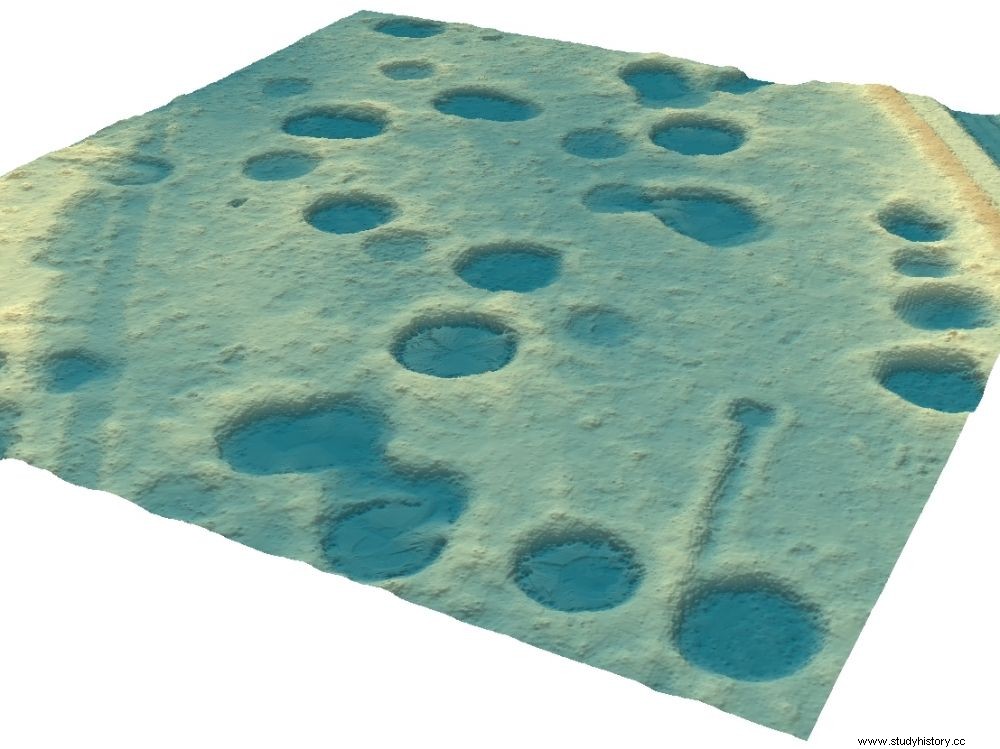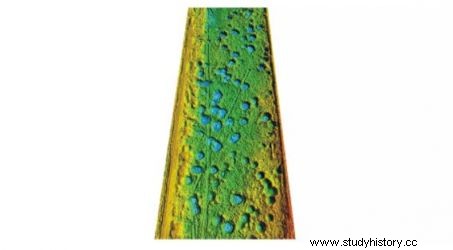In the final phase of the Second World War, the Kozle basin in Poland was one of the areas of Europe most devastated by Allied aerial bombardments. Archaeologists have undertaken to study the remains using Lidar technology.

3D surveys of WWII bomb craters identified in Kozle Basin, Poland.
The Second World War was marked by numerous strategic bombings in Europe, in particular in the industrial areas of the Reich (Germany). In 1944, the Allies (Great Britain, United States) thus dropped nearly 40,000 bombs on the Kozle basin located in a region of Germany that is now Polish. This was indeed home to one of the most important German industrial areas. However, Polish archaeologists would like to preserve the traces of this devastated territory, as a memory.
 The Kozle basin region, Poland. ©Antiquity
The Kozle basin region, Poland. ©Antiquity
And they now have the opportunity to do so thanks to the production of a geomorphological map from Lidar surveys, this remote sensing method that uses laser pulses to scan the ground and reveal its characteristics. Some 6,000 bomb craters have already been mapped. Remains for which paleogeographers are now asking for protection, for their historical and ecological value, according to a recent article published in the journal Antiquity .
 In Upper Silesia, the landscape of the Kozle region completely changed by the bombardments of the Second World War. ©Jan M.Waga - University of Silesia - Katowice
In Upper Silesia, the landscape of the Kozle region completely changed by the bombardments of the Second World War. ©Jan M.Waga - University of Silesia - Katowice
Chemical factories established in the heart of Upper Silesia as early as the 1930s
Most research in the archeology of the conflicts had until now rather focused on the bombarded regions of northern France, Belgium and the Netherlands. And the impact of the bombings on Polish natural landscapes had been little examined. "The study of the Kozle Basin is an important contribution to taking stock of the upheavals experienced by natural landscapes of this region", explains Maria Fajer, from the University of Silesia, in Katowice (Poland), joined by Sciences et Avenir . It was in the heart of Upper Silesia that many chemical factories had been established since the 1930s. Until 1940, the increase in the number of mechanized units (panzer, aviation, etc.) had required the proliferation of hydrocarbon production plants to supply fuel to the army - the Wehrmacht – and air, the Lutwaffe . And the most important of these production units of the Third Reich had been installed in the Kozle basin. To name but a few, the Blechhammer industrial site, for example, produced 350,000 tons of fuel annually; and that of Werke Heydebreck, 300,000 tons. As early as 1943, the Allies had taken the decision to destroy these refineries, which would be done on a large scale via bomber attacks from the Royal Air Force (RAF) and the US Air Force (USAF) from May 1944.
 Allied bombings over IG-Farben petrochemical plants during World War II. ©Antiquity
Allied bombings over IG-Farben petrochemical plants during World War II. ©Antiquity
5238 craters 10 to 15 m in diameter
Bombings which will also generate very heavy human losses on the Allied side due to the presence of numerous anti-aircraft batteries near German petrochemical plants. Among the tens of thousands of bombs dropped from the air, the most powerful - weighing 226 kg and 113 kg - were intended to pierce buildings made of reinforced concrete or metal structures. They are the ones who dug very exactly 5238 craters 10 to 15 m in diameter, to which are added 700 smaller craters. All now relate this region to the great European battlefields of the Second World War, according to these specialists. Not to mention the still current presence of unexploded bombs (UXB for unexploded bomb ) which is now monitored by a team specializing in environmental risks from the Faculty of Natural Sciences of the University of Silesia.

Remains of bomb craters detected by Lidar in the Kozle Basin, Poland. ©Maria Fajer et al.
"In addition, over time, these craters located in wetlands of the Kozle Basin have become new elements of the regional forest ecosystem. They offer shelter to many species of amphibians, reptiles, insects, birds or ungulates, not to mention plant species" , adds Maria Fajer.

Bomb craters turned into swamps. ©Maria Fajet et alii.
Over time, they have indeed turned into bodies of water and marshes, hence this request for heritage protection of the Kozle landscape. "While it is clear that this region of Poland needs economic development, it is also necessary to preserve the memory of the dramatic events that took place there 75 years ago " , concludes Maria Fajer.
